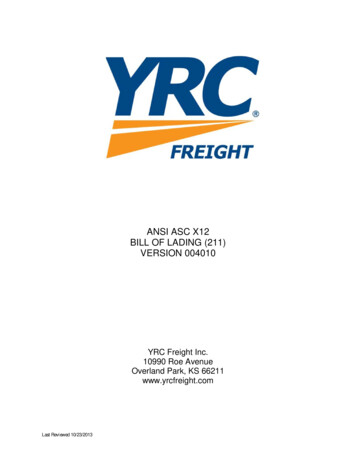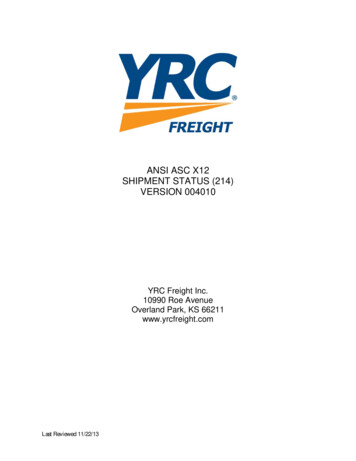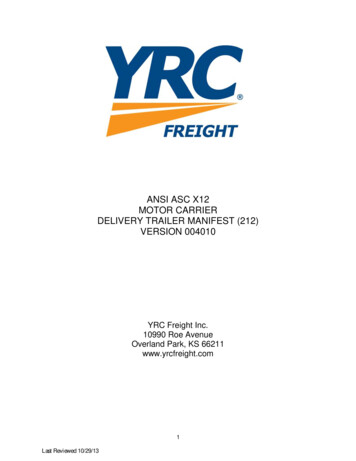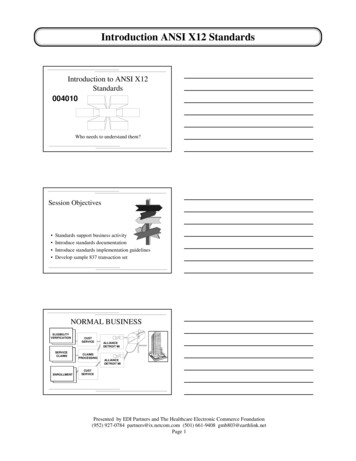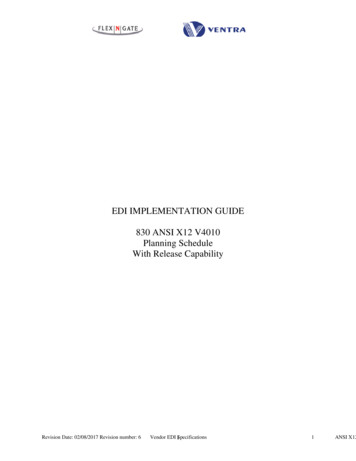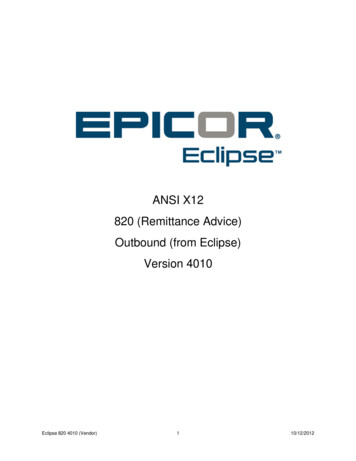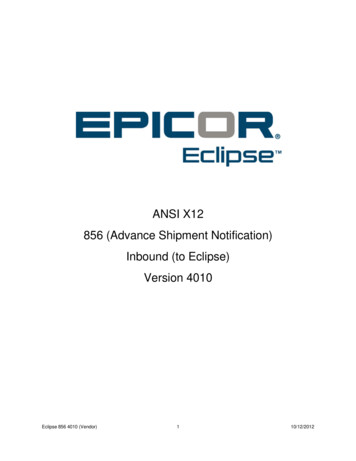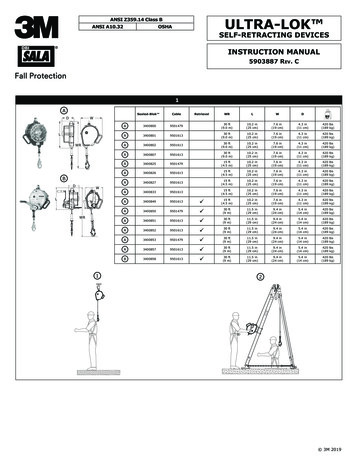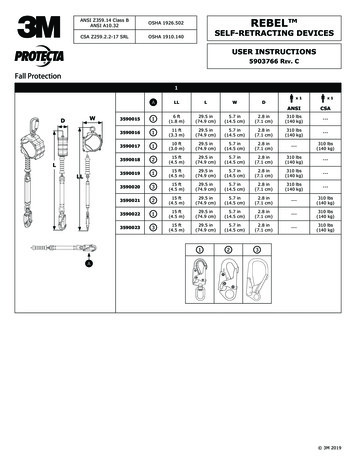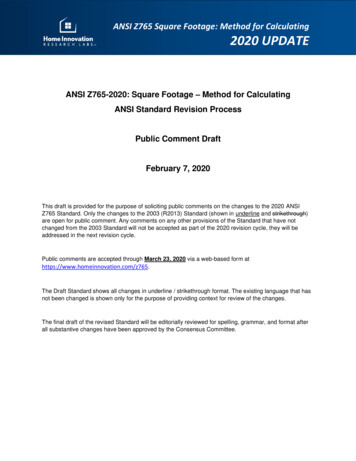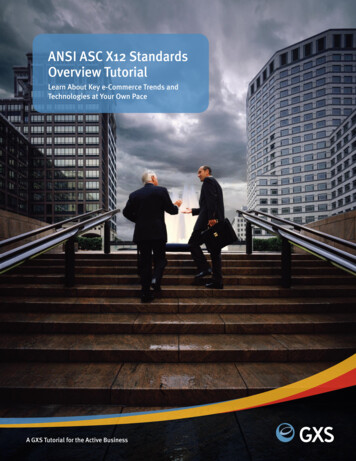
Transcription
ANSI ASC X12 StandardsOverview TutorialLearn About Key e-Commerce Trends andTechnologies at Your Own PaceA GXS Tutorial for the Active Business
Welcome. 3How To Use This Tutorial. 3Tutorial Objectives. 4Standards 101. 4Why Standardize?. 4What is a Standard?. 5What is ANSI? ANSI ASC X12?. 5What are the “X12 Standards”?. 6What is a Transaction Set?. 6Structure. 7Segments and Sequence. 7Beginning and Ending. 7Unique Segments. 8Transaction Set Segment Requirements Designation. 8MAX Use. 8Loops. 9Nested Loops.10Summary.10Segment Structure. 11Data Segment Types.13Summary.14Qualifiers and Values In ANSI ASC X12.14Data Element Types.15Composite Structures.16Summary.17Envelope Process.17Envelope Structure.17Transaction Set Envelopes.18Functional Group Envelopes.19Functional Group Sub Addressing. 20Interchange Envelopes.21Summary of Envelopes.21Group Level FA. 22Error Reporting. 23ANSI Wrap-up. 23ANSI ASC X12 Standards Overview Tutorial 2GXS Proprietary and Confidential Information
ANSI X12—this overview provides need-to-know information on the ANSI X12 standards forelectronic data interchange (EDI), including transaction sets, data elements and functionalacknowledgements.WelcomeThis tutorial is an overview of the ANSI ASC X12 Standard format.The topics covered in this module are: Objectives of this tutorial and how to use it ANSI ASC X12 101—some basic information about Standards and ANSI Transaction Sets—structure, segments, loops, etc. Segments—structure, interpretations, conditions, etc. Data Elements—what they are and how to use them Message Structure and Enveloping—packaging it all Functional Acknowledgments—who needs them?How To Use This TutorialThis tutorial provides basic information about ANSI and ANSI ASC X12. It should be used asa prerequisite to understanding what ANSI ASC X12 is and how ANSI ASC X12 is developingstandards to meet the needs of electronic commerce solutions.It is only the beginning. This tutorial will introduce terms and concepts that you will find necessary to form an awareness of the ANSI ASC X12 standards.The best way to use this tutorial is to read through a module and its subtopics, though notnecessarily at one sitting. Each module in this tutorial builds on information presented in earliermodules but an individual subtopic can be used as reference outside of the linear progression ofthe course. You will find summaries at the end of each module and exercises throughout so youcan evaluate your understanding of the material.Please send all feedback to Client Training at: training@gxs.comANSI ASC X12 Standards Overview Tutorial 3GXS Proprietary and Confidential Information
Tutorial ObjectivesAfter completing this tutorial, you should be able to discuss: What is ANSI and ANSI ASC X12 How and why the ANSI ASC X12 standard was developed What is the basic structure of the ANSI ASC X12 format How ANSI ASC X12 documents are read What Functional Acknowledgments are and why are they used How the ANSI ASC X12 standard may be used in providing electronic commerce solutionsStandards 101Why Standardize?There are almost as many business computer programs as there are businesses. In the early days,each business had its own programs for tracking merchandise, ordering, invoicing, accounts payable, receivable, and other business needs. We soon realized that:The computer programs of one business couldn’t talk to those of another which meant that alldata that was received would need to be re-entered.The programs in one department of a business couldn’t talk to those of another in the same business—order entry couldn’t talk to invoicing which couldn’t talk to accounts receivable. Requireddata needed to be re-entered two, three or more times.The answer was to standardize the data that was read by a computer program so that the datacould be read by all programs with that standard. Can you read the purchase order below?Human readable purchase Z12.75.45.953.006900P4501640Y1507CELLULOSE SPONGESPLASTIC PAILSDISH DRAINER6" FLOWER POTSANSI ASC X12 Standards Overview Tutorial 4GXS Proprietary and Confidential Information
Standards translate the ‘human readable’ invoice to a ‘machine readable’ format (ANSI X12 version/release 004010*):IT1*1*3*CA*12.75**VC*6900 N/LIT1*2*12*EA*.457**VC*P450 N/LIT1*3*4*EA*.95**VC*1640Y N/LIT1*4*1*DZ*3**VC*1507 N/L*Note: All examples in this tutorial are based on ANSI ASC X12 version/release 004010 unlessotherwise notedWhat is a Standard?A standard is a method of coding data to facilitate Electronic Data Interchange (EDI).It provides: Rules of syntax Definition of the data organization Editing rules and conventions Published public documentation (i.e., a standards manual)This provides the standards user with: An open system—where trade is possible with anyone who uses the same standard Reduced implementation effort—the implementation of a standard can, itself, bestandardized Third-party interfaces—software and network applications can be written that addressspecific business needs and conform to a single standardWhat is ANSI? ANSI ASC X12?ANSI is an abbreviation for the American National Standards Institute that has been coordinating standards in the United States since 1918. ANSI offers an open forum for all concerned toidentify needs, create plans to meet those needs, and come to an agreement on the proposedstandards.The Institute has a number of committees including the ANSI Accredited Standards CommitteeX12 (ANSI ASC X12). This committee is a voluntary standards committee that consists of subcommittees representing both private and public sectors in many industries. The subcommittees usea consensus process to propose a new standard or changes to existing standards. These standardsenable the electronic exchange of business transactions.The standard that has been recommended by this committee is known as the ANSI ASC X12Standard. It is sometimes called the ANSI X12 Standard or simply the X12 Standard.ANSI ASC X12 Standards Overview Tutorial 5GXS Proprietary and Confidential Information
What are the “X12 Standards”?So, you might ask, what are the X12 Standards? How do I get them and what do I get?You can order the X12 Standard by contacting:Publications DepartmentData Interchange Standards Association7600 Leesburg Pike, Suite 340Falls Church, VA 22043Phone: (703) 970-4480FAX: (703) 970-4488e-mail: publications@disa.orgInternet: www.disa.orgYou will receive the X12 Standards manual that includes: Transaction Set Tables—Transaction Sets are commonly used business transactions (PO,Invoice, etc.). They are made up of Segments which are made up of Data Elements. Segment Directory—A listing of all possible segments. Data Element Dictionary—A definition for all possible data elements. Code Sources—ANSI ASC X12 allows industry-specific codes. These codes are not maintained by the ANSI ASC X12 committee, but by industry organizations. A list of where toobtain these industry codes can be found in the ASC X12 Standards manual. Interactive Control Structure—These are syntax rules at the application level that have beenagreed upon by the United Nations Economic Commission for Europe (UN/ECE) forElectronic Data Interchange for Administration, Commerce, and Transport (EDIFACT).What is a Transaction Set?A Transaction Set is a single business document such as a Purchase Order, Invoice, or ShipmentNotice. There are hundreds of Transaction Sets available in the ANSI ASC X12 standards. Eachset of transaction data is identified by a three digit code number.Shi p N o t i c e856Invo ice810P u r c h ase Or der850ANSI ASC X12 Standards Overview Tutorial 6GXS Proprietary and Confidential Information
StructureMany Transaction Sets have three parts. The segments that may be used in each of these parts,within a specific document (i.e., invoice), are specified in associated tables defined in the X12Standards document. For example:STBE G.HE ADE RTable 1—The Header AreaP O1.DE TAI LCTTSES U M MARYTable 2—The Detail AreaTable 3—The Summary AreaSegments and SequenceThe tables show which segments may be used in a Transaction Set and the required sequence ofthe segments. For example, the Purchase Order Transaction Set table action Set HeaderBeginning Segment for Purchase OrderCurrencyReference IdentificationAdministrative Communications ContractTax ReferenceF.O.B. Related InformationPricing InformationPeriod AmountSales RequirememntsCommodityetc.etc.Beginning and EndingTransaction Sets: Begin with the Transaction Set Header (ST) segment End with the Transaction Set Trailer (SE) segmentANSI ASC X12 Standards Overview Tutorial 7GXS Proprietary and Confidential Information
These two segments are the innermost level of the three levels of envelopes within the 850 Purchase Order.The FIRST SegmentSTBEG.HE A DE RPurchase OrderPO 1.DE TA I LThe LAST SegmentC TTSES U MMA RYEnveloping is discussed later in this course.Unique SegmentsMany Transaction Sets have a unique beginning segment that immediately follows the ST segment. Here are a few examples of transaction sets that contain unique beginning segments:Transaction Set:----------------Purchase Order-----------------Price/Sales Catalog-----------Ship Notice-----------------------Beginning Segment:850 BEG Segment832 BCT Segment856 BSN SegmentTransaction Set Segment Requirements DesignationThe standard provides a requirements designator for each segment. The requirements designatorindicates if the segment is required, optional or conditional.MandatoryOptionalFloatingAt least one occurrence must appear in the Transaction Set.May be used if needed.Floating segment that may appear anywhere in the transaction set betweenthe ST and SE segments (valid in Standard version/releases 003060 and earlier).MAX UseThe Transaction Set table shows specific attributes of a segment. The MAX use column of thesegment detail table shows how many times you may repeat a particular segment at its location inth
What are the “X12 Standards”? So, you might ask, what are the X12 Standards? How do I get them and what do I get? You can order the X12 Standard by contacting: Publications Department Data Interchange Standards Association 7600 Leesburg Pike, Suite 340 Falls Church, VA 22043 Phone: (703) 970-4480 FAX: (703) 970-4488 e-mail: publications@disa.orgFile Size: 1MBPage Count: 23
